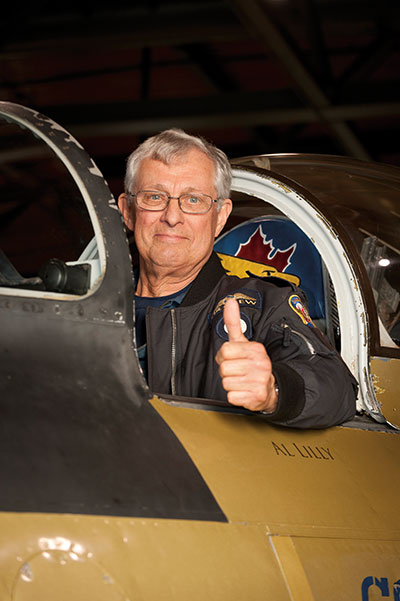
Features
Operations
Waypoint: Sharing landmark experiences
I’ve said this before but it bears repeating: every so often I have lunch with someone in the aviation industry who hasn’t forgotten important details about things you think you already know.
September 6, 2013 By Rob Seaman
I’ve said this before but it bears repeating: every so often I have lunch with someone in the aviation industry who hasn’t forgotten important details about things you think you already know. The benefits of said lunches and the information derived are priceless.
 |
|
| “By the time he reached the nearest farm, he was fully suffering the effects of winter.” PHOTO: Peter Handley
|
Paul Hayes is one such individual. Recognized by many as the current chair of COPA (Canadian Owners and Pilots Association), Hayes has a very colourful, intriguing background and is without question an aviation “addict.”
A member of COPA for more than 40 years, Hayes was, prior to becoming chair, a director and national secretary on the executive committee. He is also past captain of COPA Flight 44 (Buttonville) and president of the Buttonville Flying Club.
What many don’t know is Hayes served his country during the “Golden Age” of the Royal Canadian Air Force (RCAF). He joined the RCAF Auxiliary in 1951 – before he had a driver’s licence. He even talks about finding his way to then somewhat remote Downsview air force base by bus and on foot.
Receiving his pilot’s wings in 1953, he flew Vampire and F-86 jet fighters with 411 “County of York” squadron in Toronto. In 1956, he joined the RCAF regular force.
Hayes’ stories from that time period are telling. One example is the time he and another pilot launched from Downsview in their Vampires and flew to the Trenton gunnery range. After several passes on the ground targets, his colleague declared a fuel emergency (Vampires were notorious for their fuel hungry ways).
“He found a field and managed a gear up landing,” says Hayes. “After the aircraft came to stop in the snow, he then climbed out and had to walk to the nearest farm. Not wearing a full winter military ‘kit’ meant making the trek in regular shoes and flight suit. By the time he reached the nearest farm, he was fully suffering the effects of winter.” Hayes says this taught him to always fly according to the season. To this day, he carries a survival kit and dresses for the weather.
After becoming a full-time member of the air force, Hayes served in Europe from 1957 to 1963 as a pilot on the F-86 Sabre, first with 422 (Fighter) Squadron and then as tactical advisor to 73 Wing of the German air force.
In a piece he penned for Vintage Wings of Canada a few years back entitled, “Achtung Saberjetz – Teaching the New Luftwaffe,” Hayes recalled his activities from this time.
“When the post-war Luftwaffe was formed, the best available type of aircraft for them was the Canadian-built Canadair Sabre 6. Accordingly, 225 brand new examples were ordered, complemented by 75 Sabre 5s drawn from the Canadian Air Division (the RCAF was upgrading to the Sabre 6).
By 1961, Hayes was assigned as a tactical advisor to JG 73 (Jagdgeschwader or Fighter Wing 73). A number of the pilots had Second World War experience, mainly on fighter operations, a benefit in adding to the understanding and achieving proficiency. By mid-1962, the first four aircraft were placed on NATO “alert” at the end of the runway.” Hayes notes how proud he is to have had the opportunity to fly with a great group of German aviators and to add to his Sabre flying experiences. “Both made up a marvellous ride.”
Upon his return to Canada, Hayes held various flying and administrative positions until leaving the Regular Force in 1964 to continue his university studies. He then rejoined 411 Air Reserve Squadron, eventually serving as commanding officer from 1976 to 1978. He was appointed chief operations officer and deputy commander of 2 Air Reserve Wing prior to his becoming commander of the Wing
in 1979.
In 1982, he was transferred to the staff of the Chief of Reserves and Cadets at National Defense Headquarters. He rejoined the Air Reserve Group Headquarters in 1984 and as chief staff officer, training, and was promoted to brigadier-general in 1988, serving
as commander of Air Reserve Group
until 1990.
In 2000, Hayes was appointed honorary colonel of 400 “City of Toronto” Tactical Helicopter Squadron, based at CFB Borden. He also assists as the technical advisor to Vintage Wings of Canada regarding the operation of their Sabre – Hawk One. Outside the military and COPA, Hayes has participated in the NAV CANADA working committee restructuring the Windsor-Toronto-Montreal airspace. This reorganization of the airspace included several control zones, elements of the class C airspace and the establishment of new VFR flight routes for the GTA.
This is merely a snapshot of Hayes’ impressive work in the aviation industry. He is certainly a man of influence, someone get to know – and he’s certainly not slowing down any time soon.
Rob Seaman is a Wings writer and columnist.